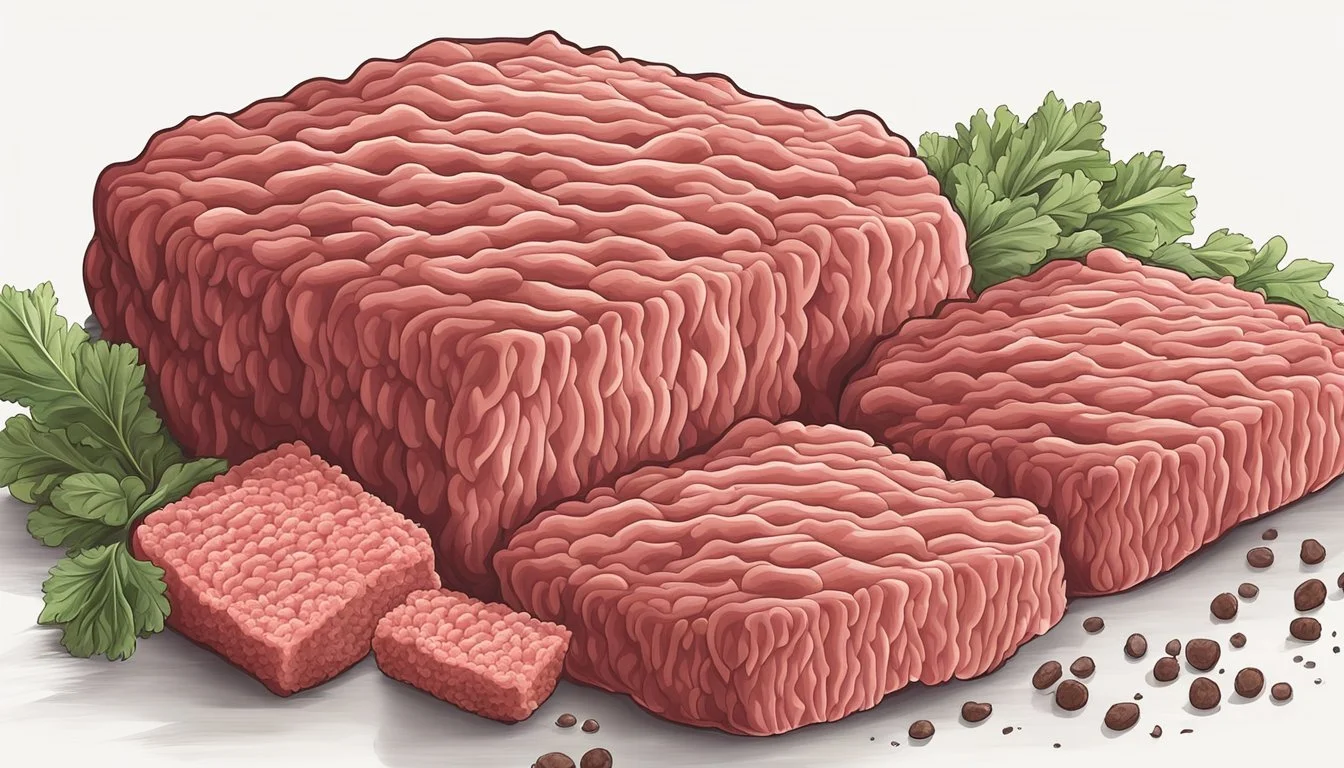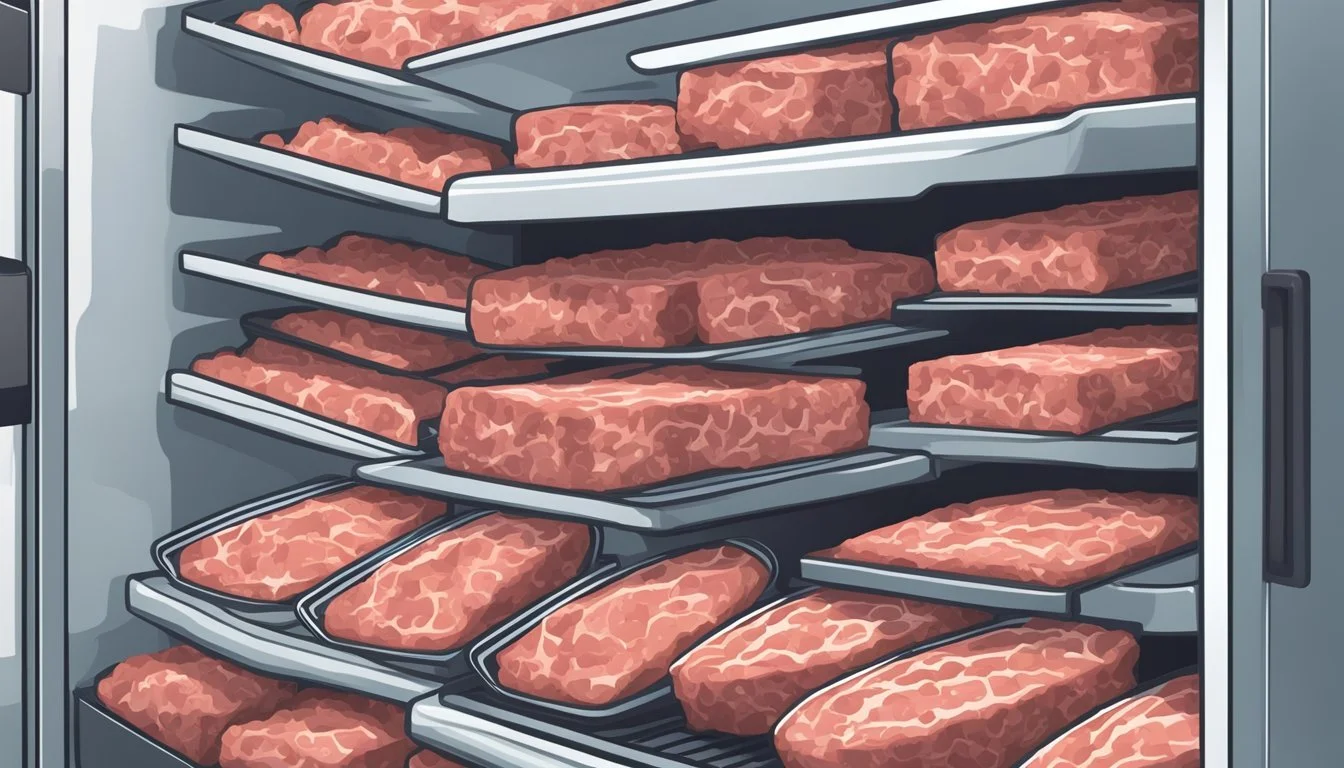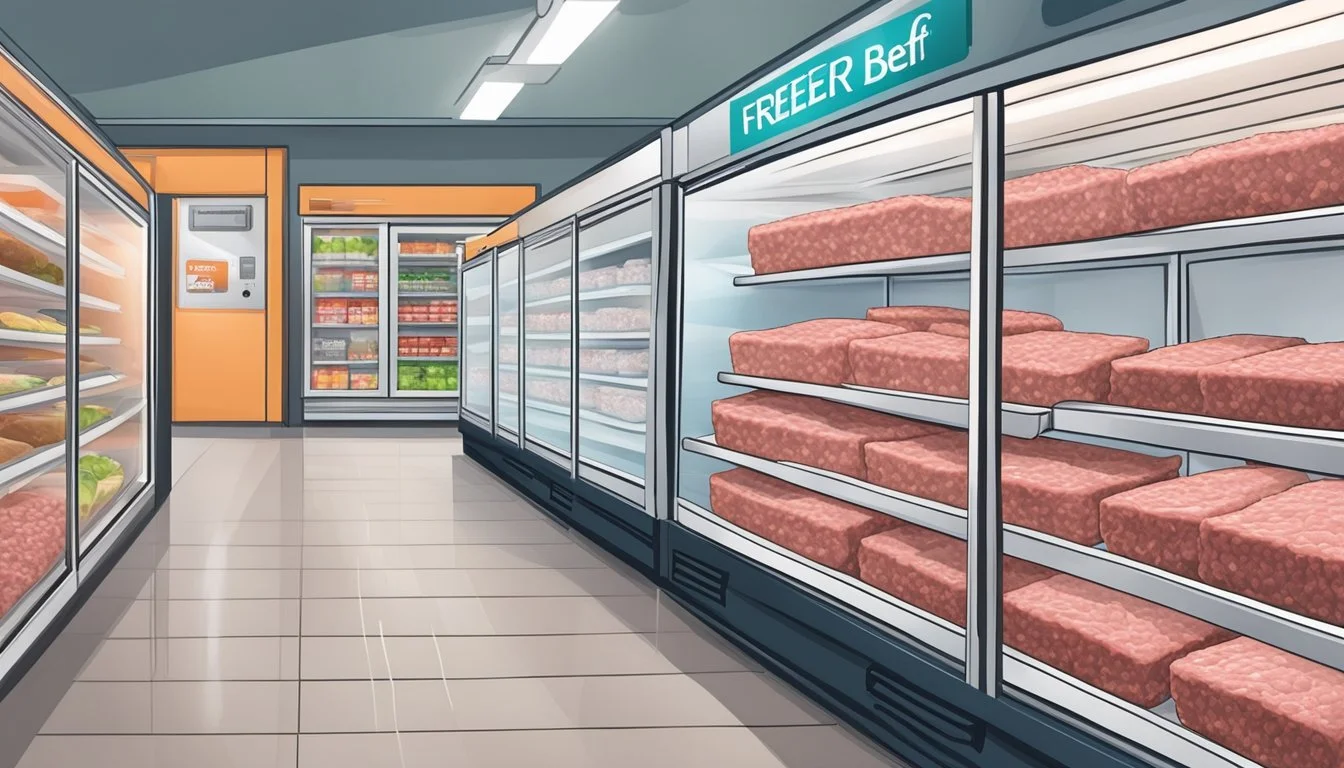Frozen vs Fresh Ground Beef: Patty Perfection Debate
Ground beef is a staple in many households, but the choice between frozen and fresh options can impact taste, texture, and overall quality. Fresh ground beef typically offers a firmer texture and more pronounced flavor compared to its frozen counterpart. This difference stems from the formation of ice crystals during the freezing process, which can slightly alter the meat's structure.
When it comes to quality, both fresh and frozen ground beef can be excellent choices if handled properly. Fresh ground beef is often perceived as superior due to its immediate availability and lack of processing. However, modern flash-freezing techniques have significantly improved the quality of frozen ground beef, preserving its nutritional value and minimizing texture changes.
Convenience and shelf life are important factors to consider. Fresh ground beef should be used within a few days of purchase, while frozen ground beef can be stored for several months without significant quality loss. This extended storage capability makes frozen ground beef an attractive option for those looking to reduce food waste and always have meat on hand for quick meal preparation.
Understanding Beef Quality
Beef quality encompasses various factors that influence taste, texture, and overall eating experience. Careful consideration of these elements allows consumers to make informed choices when selecting ground beef.
Factors Influencing Beef Quality
Breed, age, and diet of cattle play crucial roles in determining beef quality. Angus and Wagyu breeds are known for producing high-quality, well-marbled meat. Younger cattle typically yield more tender beef. Grass-fed cattle produce leaner meat with a distinct flavor profile compared to grain-fed animals.
Environmental conditions and stress levels during the animal's life can impact meat quality. Proper handling and transportation minimize stress, resulting in better meat texture and color.
Processing methods, including cutting techniques and storage conditions, significantly affect the final product quality. Proper temperature control during processing and distribution is essential for maintaining beef freshness and safety.
Aging and Tenderization
Beef aging is a controlled process that enhances tenderness and flavor. Two main methods are used: dry aging and wet aging.
Dry aging exposes beef to air in a temperature-controlled environment for several weeks. This process concentrates flavors and naturally tenderizes the meat through enzyme activity.
Wet aging involves vacuum-sealing beef and storing it in refrigerated conditions. This method is more common and cost-effective, though it produces a milder flavor compared to dry aging.
Research shows that aging periods of 14-21 days typically yield optimal tenderness and flavor development in beef.
Freshness Indicators in Beef
Color is a key indicator of beef freshness. Fresh beef should have a bright cherry-red color. Brown discoloration may indicate oxidation or age.
Texture is another important factor. Fresh beef should feel firm and slightly moist to the touch. Sticky or slimy textures can indicate spoilage.
Odor can reveal much about beef quality. Fresh beef has a mild, clean scent. Any strong or unpleasant odors suggest deterioration.
Packaging integrity is crucial for maintaining freshness. Look for securely sealed packages without tears or leaks. Check expiration dates and storage instructions to ensure optimal quality.
Nutritional Aspects
Frozen and fresh ground beef offer different nutritional profiles. The freezing process and storage duration can impact nutrient content. Understanding these differences helps in making informed choices for nutritious meals.
Nutritional Comparison
Fresh ground beef typically contains higher levels of certain vitamins and minerals compared to frozen varieties. It generally has a lower sodium content and fewer additives. Frozen ground beef, however, can retain most of its nutritional value if properly stored and thawed.
Key nutrients in ground beef:
Protein
Iron
Zinc
Vitamin B12
Creatine
Fresh ground beef often has a slightly higher content of these nutrients immediately after processing. The difference in nutritional value between fresh and frozen beef is usually minimal when the frozen product is handled correctly.
Impact of Freezing on Nutrients
The freezing process can affect the nutrient content of ground beef. Ice crystals that form during freezing may break down some cellular structures, potentially leading to minor nutrient losses.
Nutrients most susceptible to freezing:
Water-soluble vitamins (B-complex, vitamin C)
Some minerals
However, the impact is generally small. Proper freezing techniques and packaging help minimize nutrient loss. Quick freezing at very low temperatures (-18°C or below) is more effective at preserving nutritional quality.
Considerations for Nutritious Meals
Both fresh and frozen ground beef can be part of a nutritious diet. The choice often depends on factors like convenience, cooking method, and meal planning.
Tips for maximizing nutritional value:
Use fresh ground beef within 1-2 days of purchase
Thaw frozen beef in the refrigerator to minimize nutrient loss
Cook beef to appropriate internal temperature (160°F/71°C)
Combine with vegetables and whole grains for balanced meals
Frozen ground beef offers longer storage life, which can reduce food waste. Fresh ground beef may be preferred for certain recipes where texture is crucial. Both options can provide essential nutrients when incorporated into a well-balanced diet.
Consumption and Shelf Life
Proper storage practices, understanding shelf life, and minimizing food waste are crucial aspects of handling ground beef. These factors directly impact the quality, safety, and longevity of both fresh and frozen varieties.
Storage Best Practices
Refrigerate fresh ground beef at 40°F or below and use within 1-2 days of purchase. For longer storage, freeze at 0°F or lower. Wrap ground beef tightly in freezer-safe packaging to prevent freezer burn. Use airtight containers or heavy-duty freezer bags, removing as much air as possible.
In the refrigerator, store ground beef on the bottom shelf to prevent drips onto other foods. Keep frozen ground beef in the back of the freezer where temperatures are most consistent.
Label packages with the freezing date to track storage time. Organize your freezer regularly, placing newer items towards the back and older ones in front for easier rotation.
Understanding Shelf Life
Fresh ground beef lasts 1-2 days in the refrigerator. Frozen ground beef maintains its quality for up to 4 months when properly stored at 0°F or below. While it remains safe to eat indefinitely when kept frozen, quality may decline over time.
Thawed ground beef should be used within 1-2 days. Never refreeze raw ground beef that has been thawed, as this can lead to bacterial growth and compromised safety.
Signs of spoilage include:
Gray or brown color
Slimy texture
Off odor
Always discard ground beef if you suspect it has gone bad, regardless of the date on the package.
Preventing Food Waste
To minimize waste, buy only what you need for immediate use. If purchasing larger quantities, divide into smaller portions before freezing. This allows for easier thawing of just the amount needed.
Use the "first in, first out" method when storing ground beef. Cook or freeze fresh ground beef promptly to extend its usability. When meal planning, prioritize using ground beef nearing its expiration date.
Consider cooking ground beef before freezing to extend its shelf life and make meal prep more convenient. Cooked ground beef can be safely stored in the freezer for 2-3 months.
Vacuum sealing can significantly extend the freezer life of ground beef by preventing freezer burn and maintaining quality for up to a year.
Taste, Flavor, and Texture
Fresh and frozen ground beef offer distinct sensory experiences. The freezing process can impact the taste, flavor, and texture of ground beef in various ways.
Sensory Characteristics of Fresh Beef
Fresh ground beef typically has a bright red color and firm texture. It offers a robust, meaty flavor with subtle nuances. The natural juices are retained, contributing to its succulence and tenderness.
When cooked, fresh beef develops a appealing aroma and a rich, savory taste. Its texture is often described as juicy and tender, with a satisfying mouthfeel.
Fresh beef's flavor profile can vary based on factors like the cut, fat content, and aging process. Higher fat content generally results in a more flavorful experience.
Comparing Frozen and Fresh Ground Beef
Frozen ground beef may exhibit slight differences in taste and flavor compared to its fresh counterpart. The freezing process can affect the meat's cellular structure, potentially leading to subtle changes.
Some consumers report a milder flavor in frozen beef. This could be due to the formation of ice crystals during freezing, which may dilute the natural juices and flavors upon thawing.
However, when properly frozen and thawed, the taste differences between fresh and frozen beef can be minimal. Proper handling and storage are crucial for maintaining quality.
Influence of Freezing on Texture
Freezing can have a noticeable impact on the texture of ground beef. Ice crystals formed during freezing can rupture cell membranes, leading to moisture loss upon thawing.
This moisture loss may result in a slightly drier texture compared to fresh beef. Some consumers describe frozen beef as less firm or slightly mushy after thawing.
To minimize textural changes:
Freeze beef quickly at very low temperatures
Thaw slowly in the refrigerator
Avoid refreezing thawed meat
Despite these differences, many find frozen beef perfectly acceptable for most cooking applications, especially in dishes where texture is less critical.
Freezing and Food Safety
Proper freezing techniques are crucial for maintaining food safety and quality when storing ground beef. Freezing slows enzyme activity and microbial growth, extending shelf life significantly.
The Flash Freezing Process
Flash freezing rapidly lowers the temperature of ground beef, minimizing ice crystal formation. This process helps preserve the meat's texture and nutrient content. Large-scale producers use industrial blast freezers to achieve temperatures as low as -40°F (-40°C) within minutes.
For home cooks, placing ground beef in single-layer portions in the coldest part of the freezer can simulate flash freezing. Wrapping the meat tightly in plastic wrap or freezer paper before placing it in a freezer bag removes air and prevents freezer burn.
Thawing Techniques and Safety
Safe thawing is essential to prevent bacterial growth. The refrigerator method is the safest, allowing ground beef to thaw slowly at a consistent, safe temperature. Place the frozen meat on a plate to catch any drips and allow 24 hours for every 5 pounds.
For faster thawing, the cold water method submerges sealed packages in cold tap water, changing the water every 30 minutes. Microwave thawing is quick but can partially cook the meat, requiring immediate full cooking afterward.
Never thaw ground beef on the counter at room temperature, as this promotes bacterial growth in the outer layers while the center remains frozen.
Risk of Freezer Burn
Freezer burn occurs when air reaches the surface of frozen food, causing dehydration and oxidation. While not unsafe, it can affect taste and texture. To prevent freezer burn, remove as much air as possible from packaging before freezing.
Use moisture-vapor resistant wraps or containers. Double-wrap ground beef for extended storage. Label packages with the date to ensure rotation. Even with freezer burn, ground beef remains safe to eat if stored at 0°F (-18°C) or below, though quality may decline over time.
Cooking and Preparation Techniques
Ground beef offers versatility in the kitchen, whether fresh or frozen. Proper techniques ensure optimal flavor and safety when cooking this popular meat.
Preparing Ground Beef for Cooking
Thawing frozen ground beef safely is crucial. Place it in the refrigerator 24 hours before cooking. For quicker thawing, use cold water, changing it every 30 minutes. Avoid room temperature thawing to prevent bacterial growth.
Fresh ground beef requires less preparation. Remove it from packaging and pat dry with paper towels to enhance browning. Season the meat just before cooking to prevent drawing out moisture.
Divide ground beef into portions before freezing for easier thawing later. This allows for quicker defrosting and more convenient meal planning.
Cooking Frozen vs Fresh Ground Beef
Fresh ground beef cooks more evenly and quickly. It's ideal for burgers, meatballs, and dishes requiring precise shaping. Use a hot skillet or grill for optimal browning and flavor development.
Frozen ground beef can be cooked directly, though it takes longer. Break it into chunks as it cooks in the skillet. This method works well for recipes like tacos or spaghetti sauce.
For best results with frozen beef, use a lower heat and longer cooking time. Stir frequently to ensure even cooking. Add liquid ingredients later to prevent overcooking.
Effects on Internal Temperature
Achieving safe internal temperatures is vital for both fresh and frozen ground beef. The target is 160°F (71°C) for all ground beef dishes.
Fresh ground beef reaches this temperature more uniformly. Use a meat thermometer to check multiple spots, especially in thicker portions.
Frozen ground beef may cook unevenly, with some parts reaching safe temperatures before others. Frequent stirring and breaking apart larger chunks helps distribute heat more evenly.
Allow cooked ground beef to rest for a few minutes. This lets the internal temperature stabilize and juices redistribute for better flavor and texture.
Economic and Convenience Factors
The choice between fresh and frozen ground beef involves tradeoffs in cost, convenience, and availability. These factors play a key role in consumer purchasing decisions and impact household budgets.
Cost Comparison
Frozen ground beef often costs less than its fresh counterpart. Bulk packages of frozen beef can provide savings of 10-30% compared to fresh options. Retailers can offer lower prices on frozen beef due to reduced spoilage and longer shelf life.
Fresh ground beef prices fluctuate more based on supply and demand. Sales and markdowns are common as expiration dates approach. Savvy shoppers can find deals, but consistent savings are harder to achieve.
Freezing fresh beef at home can help lock in sale prices. However, this requires planning and proper storage to maintain quality.
Convenience for Consumers
Frozen ground beef offers unmatched convenience. It can be stored for months without spoiling, reducing waste and frequent shopping trips. Portioned frozen patties or crumbles allow easy meal prep.
Fresh beef requires more planning. It must be used or frozen within days of purchase. Thawing frozen beef takes time, but microwave defrosting enables last-minute meals.
Pre-seasoned fresh beef products save time but cost more. Frozen varieties offer similar convenience at a lower price point.
Availability and Selection
Fresh ground beef provides more variety in lean-to-fat ratios and grinds. Specialty blends and custom grinds are typically only available fresh. Premium grass-fed and organic options are more common in the fresh meat case.
Frozen beef selection is more limited but consistent year-round. Standard 80/20 and 90/10 lean ratios dominate frozen offerings. Some stores stock frozen organic or grass-fed options.
Rural areas may have less access to fresh beef. Frozen products help fill gaps in meat availability, especially in food deserts or regions far from processing facilities.
Special Considerations
Ground beef quality depends on several key factors beyond just freshness. Moisture content, bone inclusion, and aging methods can significantly impact taste, texture, and cooking results.
Role of Moisture in Ground Beef Quality
Moisture levels in ground beef affect its texture and cooking properties. Fresh ground beef typically contains 60-70% moisture, while frozen varieties may have slightly lower levels due to ice crystal formation. Higher moisture content can lead to juicier burgers but may also cause shrinkage during cooking.
To maintain optimal moisture:
Store fresh ground beef at 40°F or below
Use within 1-2 days of purchase
Thaw frozen beef in the refrigerator, not at room temperature
Cooking tips for moist ground beef:
Avoid overmixing, which can lead to tough texture
Form patties gently to prevent compaction
Use a meat thermometer to avoid overcooking
Choosing Between Bone-in or Ground Steak
Bone-in steaks and ground beef offer different culinary experiences. Bone-in cuts provide enhanced flavor due to marrow content but require longer cooking times. Ground steak offers versatility and quicker preparation.
Benefits of bone-in steaks:
Richer flavor profile
Ideal for grilling or slow-cooking methods
Visually appealing presentation
Advantages of ground steak:
Faster cooking time
Easier to incorporate into various recipes
More uniform texture
For optimal results when grilling bone-in steaks, use indirect heat and allow for longer cooking times. Ground steak excels in dishes like meatballs, tacos, and casseroles.
Implications of Dry Aging
Dry aging beef intensifies flavor and tenderizes the meat through controlled decomposition. This process affects both whole cuts and ground beef derived from dry-aged sources.
Key aspects of dry-aged beef:
Concentrated, nutty flavor
Improved tenderness
Reduced moisture content
Dry-aged ground beef characteristics:
May require less seasoning
Often commands a premium price
When cooking with dry-aged ground beef, use lower heat to prevent moisture loss. The reduced water content can result in a denser texture, making it ideal for upscale burgers or meat-based sauces.




